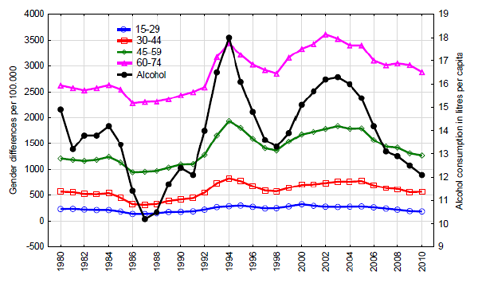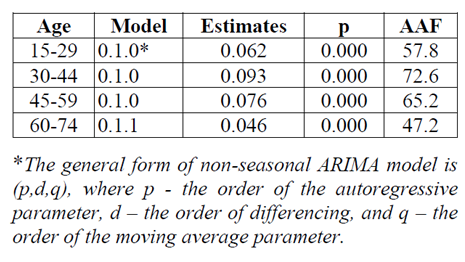Information
Journal Policies
Contribution of Alcohol to the Male-Female Health-Survival Paradox in Russia
Razvodovsky Y. E*
Copyright : © 2019. This is an open access article distributed under the Creative Commons Attribution License, which permits unrestricted use, distribution, and reproduction in any medium, provided the original work is properly cited.
There is extensive research literature that claims women have a mortality advantage compared to men in all developed countries.
This study aims to test the hypothesis that alcohol is one of the main drivers of the male-female health-survival paradox in Russia.
Time-series analytical modeling techniques were used to examine the relation between the age-specific gender gap in all-cause mortality and alcohol consumption per capita in Russia between 1980 and 2010.
The results of the analysis suggest a significant positive relationship between alcohol consumption and the gender gap in all-cause mortality in all age groups.
Alcohol appears to play an important role in the gender gap in all-cause mortality rates in Russia.
1. Introduction
There is extensive research literature that claims women have a mortality advantage compared to men in all developed countries [1]. The size of the male-female gap in mortality has been found to be smaller in Western Europe countries than in the Eastern European countries [2]. Russia has one of the highest differences in mortality between the sexes when compared to European Union countries [2]. It was hypothesized that alcohol may play an important role in explaining the pronounced gender gap in all-cause mortality in Russia [3].
The level of alcohol-related problems differs substantially across Europe, with Eastern European countries experiencing higher burden of alcohol-attributable morbidity and mortality than Western European countries [4]. Given the fact, that the level of all-cause mortality in Russia is closely related to harmful drinking [5-9], and that the level of alcohol consumption is significantly higher among men compared with women [10], it is logical to assume, that alcohol is one of the main driver of gender gap in all-cause mortality in this country.
In this study I will further test the hypothesis that alcohol is one of the main drivers of the male-female health-survival paradox in Russia by analyzing time series data on alcohol consumption per capita and age-specific gender gap in all-cause mortality rates between 1980 and 2010.
2.Methods
Age-standardized male and female all-cause mortality rates per 100.000 were taken from the WHO Mortality Database. The total level of alcohol consumption (in litres of pure alcohol) in Russia has been estimated using the indirect method based on alcohol poisonings mortality rate [11]. ARIMA (autoregressive integrated moving average) time-series analytical modeling techniques [13] were used to examine the relation between the age-specific gender gap in all-cause mortality (the difference in male and female mortality rates) and alcohol consumption per capita in Russia between 1980 and 2010. The effect of population drinking on the gender gap in all-cause mortality rates will be presented in terms of alcohol-attributable fraction. A time series analysis was performed using the statistical package "Statistica 12. StatSoft".
3. Results
The time series of age-specific gender differences in all-cause mortality rates are displayed in Figure 1. The graphical evidence suggests that the pattern of age-specific gender differences in all-cause mortality was rather similar. The trends fluctuated over time: decreased substantially in the mid-1980s, than increased dramatically between 1992 and 1994. From 1994-1998 there was a fall in the gender gap of before they again rose between 1998 and 2003 and then finally started to decrease. The graphical evidence also suggests that the temporal pattern of gender gap in all-cause mortality fits closely with changes in alcohol consumption per capita (Figure 1).
According to the results of time-series analysis, a significant positive relationship exists between alcohol consumption and the gender gap in all-cause mortality in all age groups (Table 1). The estimated effects of alcohol consumption on the gender gap in all-cause mortality rates range from 0.046 (60-74 age group) to 0.093 (30-44 age group). The results of the analysis also suggest that alcohol-attributable fraction of the gender gap in all-cause mortality rates range from 47.2% (60-74 age group) to 72.6% (30-44 age group) (Table 1).
4. Discussion
The results of time-series analysis suggest a positive and statistically significant effect of alcohol consumption on the gender gap in all-cause mortality rates in Russia. The analysis also indicates that alcohol has a greater impact on the gender gap in all-cause mortality in yang and middle age. This finding is not surprising, since the level of alcohol-related problems among middle age Russian men is especially high. An analysis of frequency of drinking by male age groups indicates that the frequency climbs steadily to a peak between ages 30-39, before decreasing slightly in the 40-44 and 45-49 year-old and from age 50 declines significantly [10].
The findings from this study need to be interpreted within the context of the methodological limitations of this research. It can be assumed that the alcohol consumption effect on gender gap in all-cause mortality is a spurious indicator of the impact of other powerful risk factors such as smoking. There is general agreement that cigarette smoking is a major contributor to the sex difference in all-cause mortality in developed countries [1]. In European Union, for example, smoking accounts for 40-60% of the gender gap in mortality [13]. However, taking into account the fact that smoking has a long term effect on mortality [2], this factor alone cannot explain the trajectories in the gender gap in Russian mortality rates during the last decades.
5. Conclusion
The findings of this study suggest a close link between population drinking and gender gap in all-cause mortality in Russia. Alcohol appears to play an important role in the gender gap in all-cause mortality rates in this country. High level of alcohol consumption and detrimental drinking pattern point to the need for public health interventions to reduce the burden of alcohol-related mortality in the Russian Federation.
References
- Barret-Connor E. Gender differences and disparities in all-cause and coronary heart disease mortality: epidemiological aspect. // Best Pract Res Clin Endocrinol Metab. –2013. –Vol. 27, №4. – P. 481 – 500.
- Van Oyen H., Nusselder W., Jagger C., Kolip P., Cambois E., Robine J.M. Gender differences in healthy life years within the EU: an exploration of the ‘‘health–survival’’ paradox. // Int J Public Health. – 2013. – Vol.58. – P. 143–155.
- Razvodovsky Y. E. Alcohol consumption and gender gap in all-cause mortality in Russia. Journal of Alcohol and Drug Dependence. 2017 5(3) 1-4.
- Moskalewicz J., Razvodovsky Y.E., Wieczorek P. East-West disparities in alcohol-related harm // Alcoholism and Drug Addiction. –20 16. – Vol. 29. – P. 209–222.
- Razvodovsky Y. E. Estimation of alcohol attributable fraction of mortality in Russia, Adicciones. – 2012. – Vol. 24, №. 3. – P. 1–7,.
- Razvodovsky YE. (2010) Beverage specific alcohol sale and mortality in Russia. Alcoholism 46:63–75.
- Zaridze D., Maximovitch D., Lazarev A., Igitov V., Boroda A, et al. Alcohol poisoning is a main determinant of recent mortality trends in Russia: evidence from a detailed analysis of mortality statistics and autopsies. Int J Epidemiol. 2009; 38: 143-153.
- Stickley A., Koyanagi A., Koposov R., Razvodovsky Y., Ruchkin Y. Adolescent binge drinking and risky health behaviours: findings from northern Russia. Drug Alcohol Dependence. 2013; 133(3): 838-844.
- Nemtsov AV, Razvodovsky YE. Russian alcohol policy in false mirror. Alcohol Alcohol.– 2016. – Vol. 4. – P. 21.
- Cockerham, C.W. (2006). Health lifestyle in Russia. Social Science & Medicine, 51, 1313-1224.
- Nemtsov A.V., Razvodovsky YE. The estimation of the level of alcohol consumption in Russia: a review of the literature. Sobriology. – 2017. – Vol. 1. – P. 78–88.
- Box, GEP. Jenkins GM. Time series analysis: forecasting and control. – London: Holden-Day Inc., 1976.
- McCartny G., Mahmood L., Leyland A.H., Batty G.D., Hunt K. Contribution of smoking-related and alcohol-related deaths to the gender gap in mortality: evidence from 30 European countries. // Tobacco Control. – 2011. – Vol. 20.– P. 166–168.






